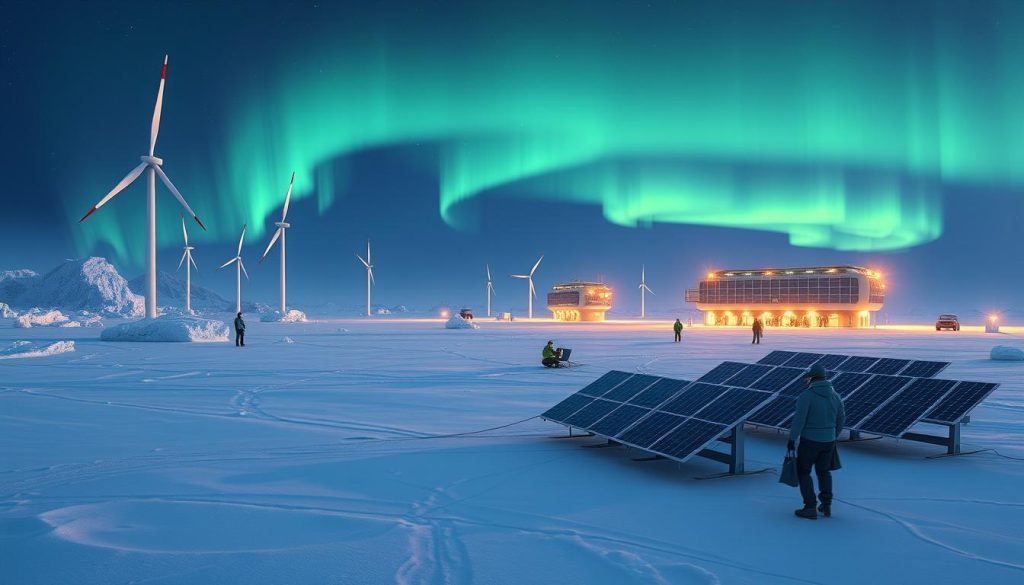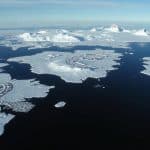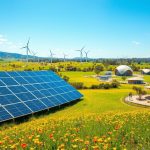More and more people see the need for sustainable energy, making Antarctic renewable energy key. This piece explores fresh ventures that use wind and solar power in one of the toughest places on Earth. These innovations meet energy needs while protecting Antarctica’s delicate ecosystem.
The Importance of Renewable Energy in Antarctica

Renewable energy is key in Antarctica, due to its special environmental challenges. These challenges grow as more people work in this important area. The need for renewable energy sources is clear as the climate changes alarm scientists.
Using wind and solar power helps protect Antarctica’s ecosystems. This switch lowers the harm from fossil fuels and cuts greenhouse gas effects. Sustainable energy could help fight climate threats effectively.
Switching to renewable energy aids environmental targets and strengthens research in Antarctica. It’s crucial for both present and future work in preserving Antarctica.
Understanding the Unique Challenges of Antarctica

The Antarctic offers unique hurdles for green energy projects. The extreme cold, going down to -60 degrees Celsius, makes it tough. This cold affects how well equipment works and causes delays. These delays challenge the project’s sustainability.
Getting stuff to Antarctica is hard due to its remote location. This distance makes shipping materials complex and costly. The little infrastructure and frequent bad weather make these tasks even harder. It’s crucial for companies to plan carefully and focus on being reliable.
In Antarctica, having access to energy is very important. Innovative ideas that work well in the extreme cold are needed. Designing systems that can handle this cold is key to the success of clean energy projects here.
Renewable Energy Business Ideas for Antarctica
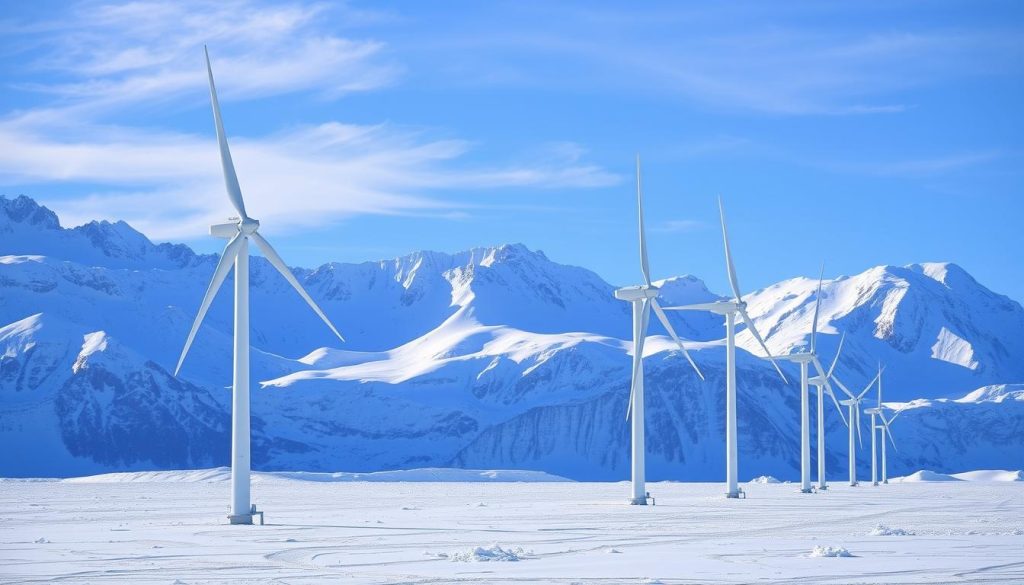
Antarctica is a special place for renewable energy businesses. Its unique weather and geography offer great opportunities. Companies can use wind and solar power to create energy. These methods work well together, giving a steady energy source in tough conditions.
Utilising Wind Energy in Extreme Conditions
In Antarctica, wind energy is a smart choice, especially where winds are strong. Developing wind turbines that can survive harsh weather is key. Vertical axis wind turbines (VAWTs) could be very useful. They could produce a lot of energy from Antarctic winds.
Harnessing Solar Power During Polar Nights
Even with long polar nights, Antarctica has potential for solar power. New photovoltaic systems work well, even in low light. Special solar panels can use moonlight and weak sunlight. This helps to keep power flowing all year round.
Current Innovations in Antarctic Renewable Energy
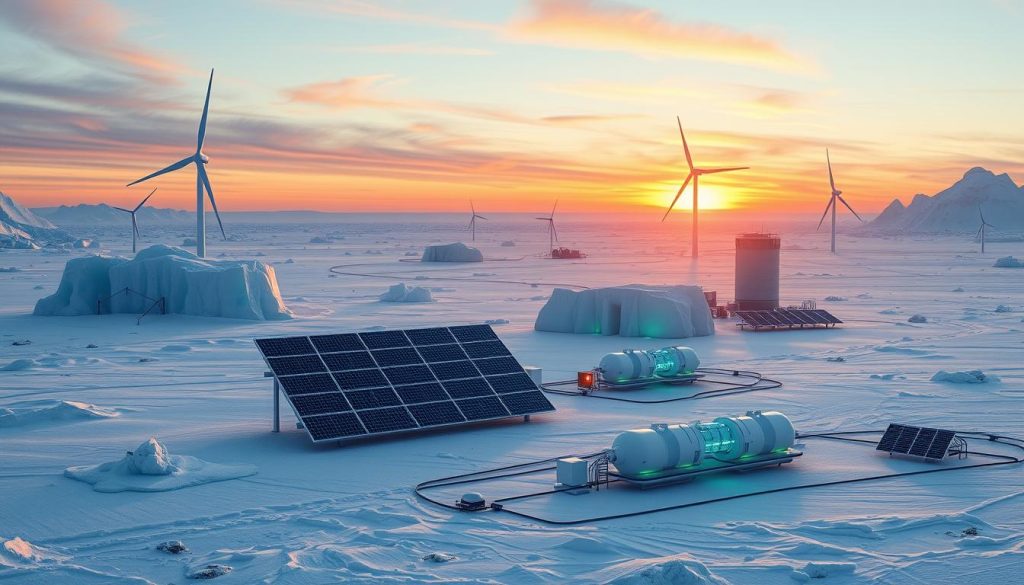
Renewable energy technologies are changing how we use energy in far-off Antarctic areas. Solar and wind power are key in making energy use better and easier in harsh conditions.
Groundbreaking Solar Technologies
New solar technologies are helping us get more energy, even in tough weather. Things like bendy solar panels and two-sided modules are making a big difference. The British Antarctic Survey has found these can really up the energy we get at science bases.
These solar advances work well in the cold and give us energy all year round.
Advancements in Portable Wind Turbines
Portable wind turbines are solving remote energy problems. They’re easy to move and set up, perfect for different places in Antarctica.
These turbines are designed to be moved easily and still make a lot of power. They help scientists get the power they need in tough Antarctic conditions.
Investment Opportunities in Antarctic Energy Ventures

The Antarctic market is ripe with opportunities, especially for renewable energy projects. The world is now more aware of climate change, creating a strong demand for green solutions. These solutions need to work well, even in the most challenging climates. As nations aim to cut down on carbon emissions, the interest in Antarctica’s energy innovations grows.
Investors are attracted to the unique chances the region offers. The harsh conditions of Antarctica push for advanced technology and creative energy solutions. This makes the area very appealing for those wanting to achieve environmental goals. Initiatives like wind and solar power are not just good for our planet. They also bring major economic advantages.
- Increased focus on energy independence.
- Potential for collaboration with government and non-profit entities.
- Emerging technologies aimed at efficiency and sustainability.
By investing in these areas, businesses and investors can help make Antarctica a leader in sustainable energy. Turning to renewable energy not only meets global eco-friendly targets but is also financially rewarding in the long run.
Case Studies of Successful Renewable Energy Projects
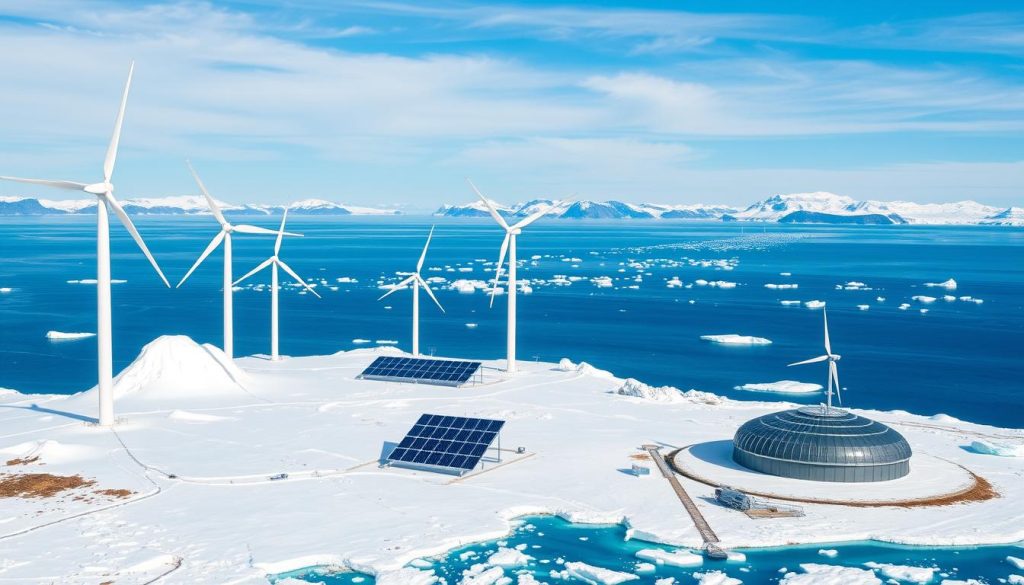
In Antarctica, groundbreaking efforts have been made to make living sustainable in one of the toughest places on Earth. These successful projects show how research bases have started using less fossil fuels. They are a big step forward in renewable technology.
The Transition to Renewable Energy in Antarctica (TREA) project is very important. It works to add wind and solar power to their energy systems. TREA has helped reduce harmful emissions and made energy use at stations more independent.
- Using wind turbines that can survive severe weather is key for reliable energy.
- Putting in solar panels, even in polar nights, helps keep energy flowing when old methods can’t.
- Optimising energy storage, which is crucial for keeping energy balanced, has been improved by learning from past projects.
Antarctica’s renewable energy projects show off new technologies but also teach us important lessons for the future. Working together and being able to adapt are crucial for using renewable energy in tough places like this.
The Role of Technology in Antarctica’s Energy Future

The future of Antarctica’s energy rests on modern technology. The need for effective energy answers grows. Innovations like smart grids and improved battery storage are key for managing energy in this special place.
Smart Grids and Their Applications
Smart grids are vital for energy supply in isolated spots like Antarctica. These systems analyze energy data in real-time. This leads to better handling of energy and easier addition of renewable sources. Smart grids help with:
- Enhanced monitoring of energy consumption and distribution.
- Improved reliability through automated response to energy demands.
- Increased efficiency across diverse energy solutions.
Smart grids change the way research stations use energy, giving steady power in extreme conditions.
Battery Storage Solutions for Remote Locations
Having reliable energy storage is crucial, especially when energy production is low. Advances in battery tech, mainly lithium-ion and new solid-state batteries, offer:
- Enhanced energy capacity and lifespan.
- Greater reliability in adverse weather conditions.
- Capacity to maintain power during seasonal fluctuations.
Strong renewable energy storage systems help research sites keep a steady energy supply all year round, ensuring efficient operations in Antarctica.
Environmental Considerations for Energy Projects
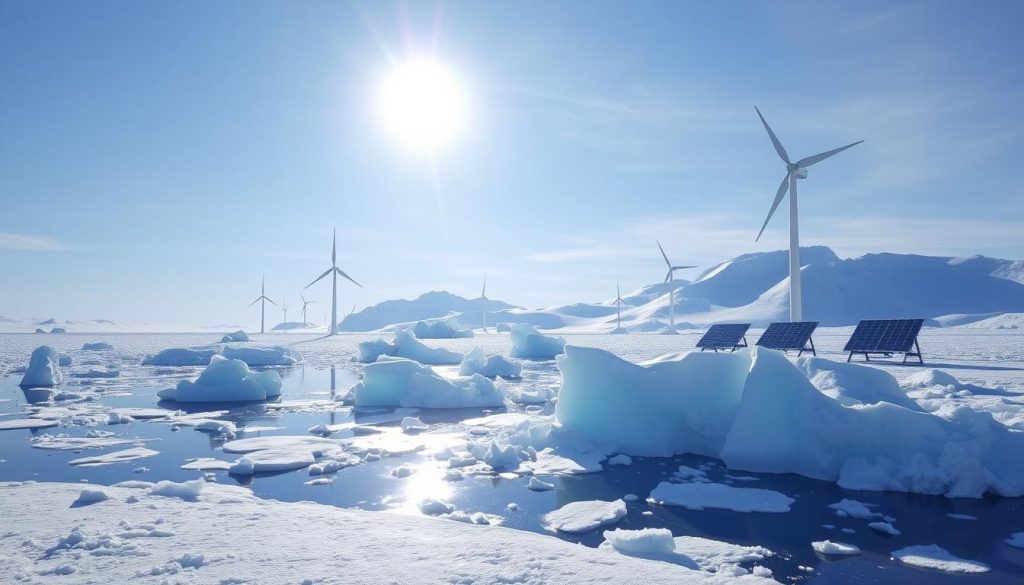
Starting renewable energy projects in Antarctica needs a deep look into how they affect the environment. It’s key to understand the balance in local ecosystems to keep wildlife safe and support sustainable ways. So, project leaders must be careful about the environment to avoid harming the region’s rich life.
Impact on Local Ecosystems
The focus on ecological issues for energy projects is mainly about saving wildlife and their homes. Important points to watch are:
- Checking how animal migration might be disrupted.
- The effects of building work on delicate habitats.
- Understanding how producing energy impacts local wildlife over time.
Detailed checks help make sure we use sustainable ways that protect all living things while still developing what we need. These checks help us remember how delicate Antarctic ecosystems are. They show why it’s critical to think about ethics in energy projects.
Building Partnerships for Antarctic Energy Initiatives

Partnerships are key to successful Antarctic energy initiatives. Governments, research bodies, and businesses must work together. This collaboration sparks innovation and pushes forward renewable energy projects. By sharing resources, they promote sustainability and long-term success.
Strong relationships among stakeholders are vital in Antarctica’s tough conditions. Partnerships facilitate the sharing of knowledge. This makes it simpler to overcome obstacles that would be hard to face alone.
It’s crucial for these organisations to:
- Leverage the expertise of multiple sectors to enhance project outcomes.
- Share funding and investment opportunities to reduce financial risks.
- Encourage joint research initiatives that promote innovation in renewable technologies.
Encouraging teamwork among stakeholders leads to greater impacts. This approach aligns everyone’s goals better. Thus, it increases the chances of major advances in renewable energy in one of the planet’s toughest spots.
The Future of Renewable Energy in Extreme Climates

The future of renewable energy in places like Antarctica looks very hopeful. We’re seeing a lot of new ideas for making energy work in tough climates. These ideas are not just good for the people living there. They also show the rest of the world how to use energy in a smart way.
Working with renewable energy in extreme climates is all about finding clever ways to deal with the cold and wind. We are developing better ways to keep energy flowing, even when the weather is against us. This is really important for making life in these tough places better.
Putting money into these new energy methods is smart. It makes our energy use safer for the planet and more reliable. When different groups work together on this, it helps make sure that renewable energy can have a bright future. This is true in Antarctica and other places with extreme weather.
Regulatory Hurdles and Solutions
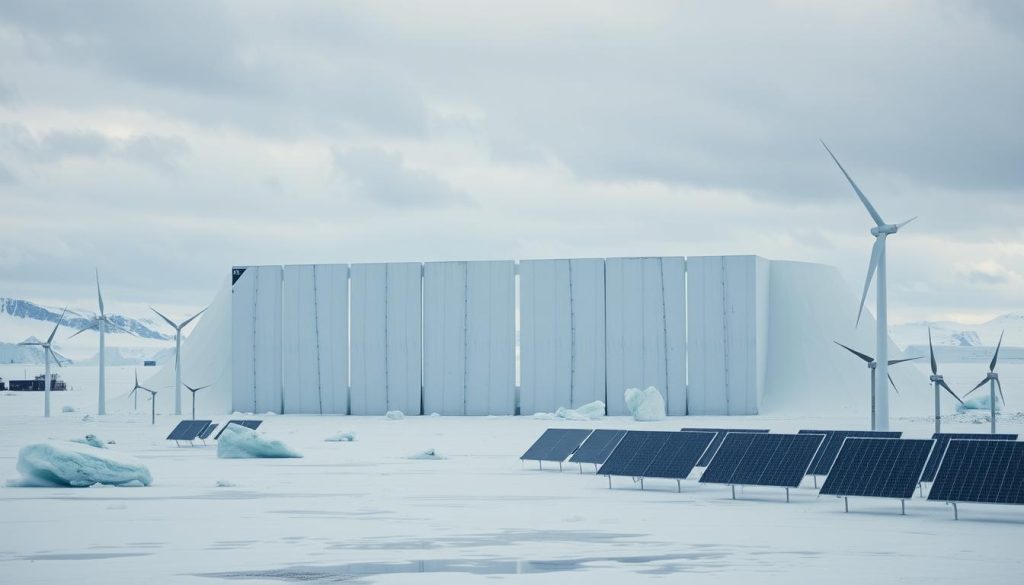
Renewable energy projects in Antarctica face big hurdles because of rules. The Antarctic Treaty System makes a complicated set of laws. It’s vital to know these laws well to move projects forward successfully.
To deal with these rules, several steps can be taken. Making the permit process simpler could speed things up. It means faster okay for new energy plans. Working together with countries involved in Antarctic energy matters will also help.
- Raising awareness about Antarctic energy rules can make people more supportive of clean energy projects.
- Joint ventures between countries can share knowledge and help with following the rules.
- Talking with local communities about energy plans can increase understanding and support.
Community Engagement in Renewable Energy Ventures
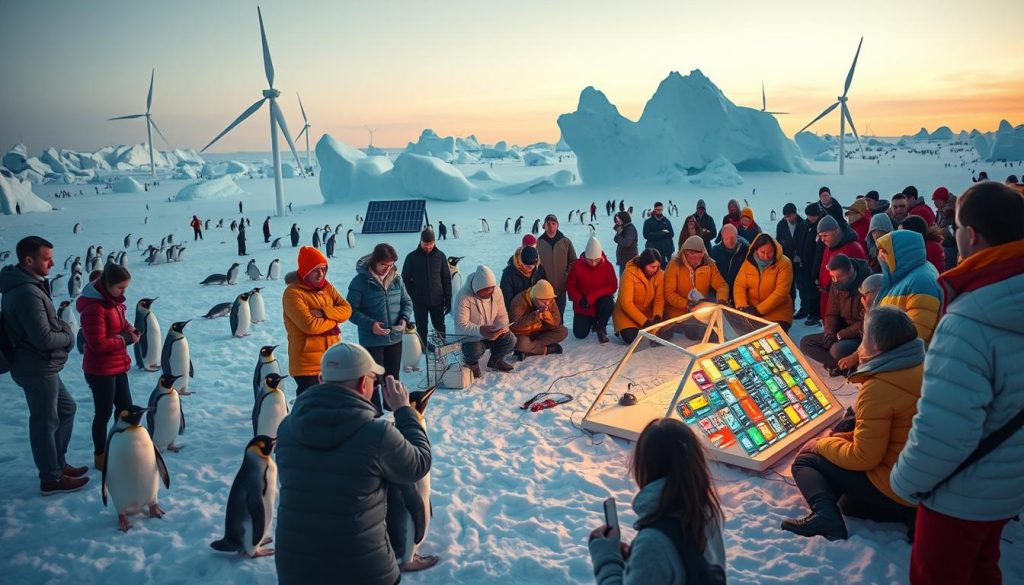
Getting communities involved in renewable energy projects is key for lasting growth. This connection helps people feel they own part of the project. It also makes the projects work better. By focusing on involving communities, we can work together both locally and around the world. This teamwork makes projects more successful.
Building Local and International Collaborations
For renewable energy projects to succeed, working together is crucial. Joining forces both locally and internationally helps share resources and ideas. By combining global knowledge with local needs, we create better solutions. This approach spreads awareness about renewable energy and builds local skills.
Educating Stakeholders on Renewable Initiatives
Teaching people about renewable energy is vital. Through workshops and training, people learn how these solutions can work for them. These efforts help everyone make better choices. They prepare researchers, locals, and investors to back up green energy. Sharing knowledge like this drives us all towards a sustainable future.
Outlook for Renewable Energy Business in Antarctica
The future of renewable energy in Antarctica looks bright, with new ideas gaining ground. As the world seeks more sustainable energy, Antarctica offers unique opportunities. The extreme conditions here mean solutions must be specially designed, attracting investors and innovators.
Renewable energy trends are moving towards more sustainable methods. Projects that consider local environmental needs stand a better chance of success. Advances in technology, along with eco-friendly strategies, can help build a strong energy system. This approach helps generate power and protect Antarctica’s untouched nature.
The teamwork between new ideas and green practices is key for future energy businesses here. By using Antarctica’s special resources wisely, these efforts can grow and inspire similar projects in harsh climates globally. Antarctica is set to influence the direction of renewable energy, aiming for a greener world.

